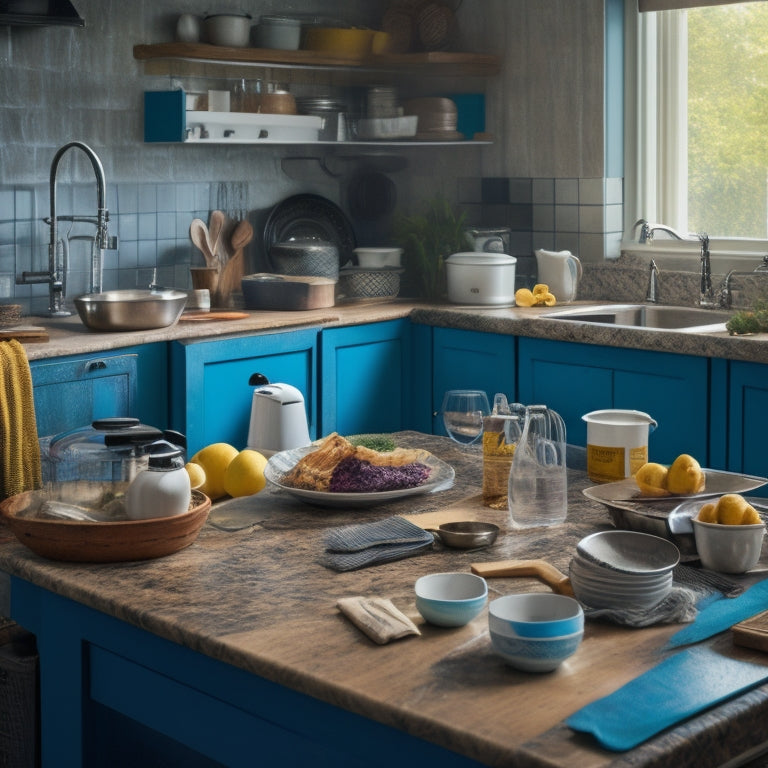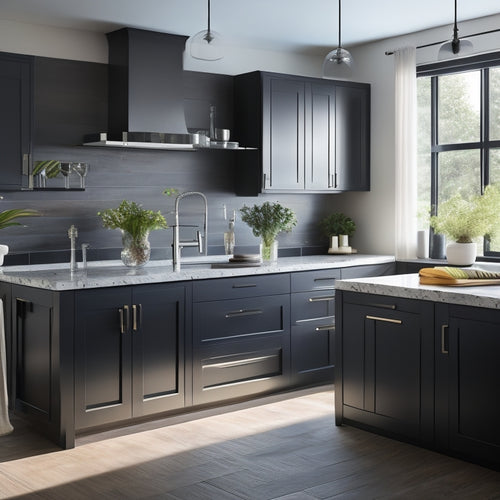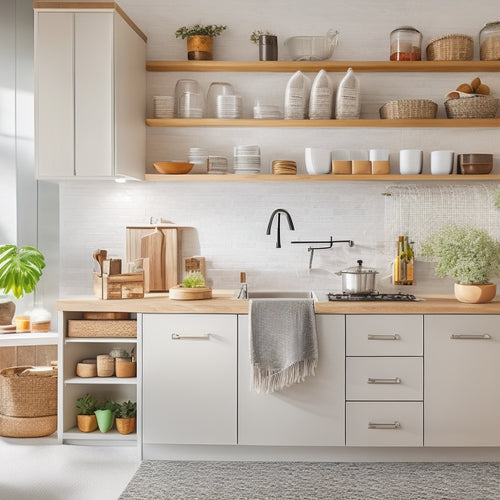
Why Can't I Create a Clutter-Free Kitchen?
Share
You're stuck in a cycle of kitchen clutter because a combination of inadequate storage, poor cabinet organization, and ineffective meal prep strategies have turned your kitchen into a disorganized nightmare. Essentials pile up on countertops, traffic flow is hindered, and prep areas are insufficient, leading to clutter. Ineffective appliance placement causes stress, and meal prep strategies lead to disorganization. To break free, you need to identify the root causes of your clutter and develop strategies to maximize storage, optimize cabinet organization, and streamline meal prep. Discover the specific solutions you need to create a clutter-free kitchen that works for you.
Key Takeaways
• Essentials piling up on countertops, poor traffic flow, and insufficient prep areas contribute to clutter buildup in the kitchen.
• Inadequate storage solutions, such as poor cabinet organization and overcrowded drawer storage, lead to disorganization and clutter.
• Clutter attracting surfaces, like magnetic strips and sticky notes, and daily habits, like not cleaning routinely, contribute to clutter buildup on countertops.
• Ineffective meal prep strategies, such as poor meal planning and cooking multiple meals, result in food wastage and disorganization.
• Failure to designate zones for prep, cooking, and cleanup, and not prioritizing meal prep tasks, hinder kitchen workflow and contribute to clutter.
Cluttered Kitchen Root Causes
One of the primary reasons you struggle with a cluttered kitchen is that you've fallen into the habit of keeping everything, from broken appliances to redundant gadgets, 'just in case' you might need them someday. This habit stems from emotional attachment and a fear of letting go.
You might hold onto grandma's old mixing bowl or your first slow cooker, thinking they'll come in handy someday or evoke nostalgic memories. However, the reality is that these items are taking up valuable space and contributing to the clutter.
Your personal habits also play a significant role in the state of your kitchen. Perhaps you're a busy bee who's always on-the-go, leaving you little time to tidy up after meals. Or maybe you're a sentimental saver, struggling to part with gifts or mementos.
Whatever the reason, it's essential to acknowledge and address these habits to create a clutter-free kitchen. By understanding the root causes of your clutter, you can begin to make conscious changes to your behavior and cultivate a more organized, peaceful space that fosters a sense of belonging.
Inadequate Storage Solutions
Your kitchen's storage spaces, from cabinets to countertops, are likely overwhelmed by clutter because they're not optimized to accommodate your cooking habits and the items you need to store. This is where inadequate storage solutions come into play. You might have too many items crammed into small spaces or not enough shelving to keep frequently used items within easy reach.
To combat this, consider implementing customized storage solutions that cater to your specific needs. For instance, you can install:
| Storage Solution | Benefits | ** Ideal For** |
|---|---|---|
| Customized Shelves | Maximize vertical space, easy access to heavy items | Heavy cookware, infrequently used items |
| Hidden Compartments | Conceal clutter, add counter space | Small appliances, snacks, or cleaning supplies |
| Pull-Out Drawers | Easy access to heavy or bulky items | Pots, pans, cooking utensils |
| Overhead Racks | Store infrequently used items, add ceiling storage | Infrequently used cookware, special occasion dishes |
| Adjustable Shelving | Adapt to changing storage needs, maximize space | Seasonal decorations, cookbooks, or gadgets |
Poor Cabinet Organization Systems
When you open your cabinet doors, what do you see?
Are cluttered corner spaces, inadequate shelf dividers, and overcrowded drawer storage staring back at you?
It's time to take a closer look at your cabinet organization systems and identify the areas that need improvement.
Cluttered Corner Spaces
Frequently, the corner spaces in your kitchen cabinets become dumping grounds for miscellaneous items, resulting in a cluttered and disorganized mess. This is often due to poor cabinet organization systems, which can lead to dead zones and wasted space. To maximize your cabinet's potential, it's essential to utilize corner spaces effectively.
Here are some common issues with corner spaces and potential solutions:
| Issue | Description | Solution |
|---|---|---|
| Dead zones | Hard-to-reach areas | Install a lazy Susan or a carousel |
| Hidden shelves | Difficult to access items | Add a pull-out shelf or a slide-out basket |
| Clutter accumulation | Items piled up | Use a corner organizer or a tiered shelf |
| Inefficient storage | Poor use of space | Implement a corner drawer or a swing-out shelf |
Inadequate Shelf Dividers
Inadequate shelf dividers can lead to a chaotic kitchen cabinet, where items are stacked haphazardly, making it difficult to find what you need quickly. You end up wasting time searching for that one specific spice or cooking utensil, which can be frustrating.
Poorly organized cabinets can also lead to cluttered countertops, as you're forced to remove items from the cabinet just to find what you need.
To avoid this, it's essential to invest in a shelf divider system that provides flexible compartments and adjustable heights. This will enable you to customize your storage space according to your needs.
With adjustable heights, you can accommodate items of varying sizes, from large serving dishes to small jars of spices. Flexible compartments will also allow you to separate similar items, making it easier to locate what you need at a glance.
Overcrowded Drawer Storage
Your kitchen drawers can quickly become overwhelmed with a jumble of utensils, gadgets, and cookware, making it nearly impossible to find what you need in a timely manner. This overcrowding leads to frustration and wasted time, which can be avoided with a few simple changes to your storage habits.
To get your drawers under control, start by implementing these strategies:
-
Use drawer dividers to separate categories of items, such as cooking utensils, baking supplies, and dinnerware.
-
Purge unnecessary items that are broken, redundant, or no longer useful.
-
Assign a home for each item, so you can easily find what you need and put it back in its designated spot.
- Store items by frequency of use, keeping the most frequently used items in easy-to-reach locations.
Countertop Clutter Buildup Reasons
When you take a closer look at your countertops, you'll likely notice that clutter tends to accumulate in specific areas. Understanding why this happens is crucial, so you can take control of the situation.
Clutter Attracting Surfaces
Recognizing the culprits behind the mess is crucial when it comes to countertops, especially those near cooking stations that become clutter magnets due to frequent food preparation and meal cleanup. Countertops can easily accumulate clutter, so it's important to identify the reasons behind the chaos.
Here are 4 common clutter attractors on your countertops:
-
Magnetic strips: Those convenient strips that hold your knives, spices, or oils can quickly become overcrowded, creating a mess on your countertop.
-
Sticky notes: While they're great for reminders, sticky notes can multiply quickly, turning your countertop into a colorful but chaotic mess.
-
Appliances: Toasters, blenders, and coffee makers might be essential, but they take up valuable space and can attract clutter around them.
- Food and snacks: Leaving food or snacks on the counter can create a trail of crumbs, spills, and packaging, making it challenging to maintain a clutter-free kitchen.
Piles Grow Unchecked Daily
Daily habits and poor cleaning routines allow clutter to accumulate on your kitchen countertops, gradually building into towering piles that seem to grow overnight. It's easy to overlook the small stuff, but those little habits add up quickly. Leaving dirty dishes overnight, not wiping down the counters after meal prep, and neglecting to put away kitchen gadgets all contribute to the clutter creep.
| Daily Habit | Morning Routine Impact | Clutter Consequence |
|---|---|---|
| Not putting away dishes | Rushed morning routine, no time to clean | Dirty dishes pile up on countertops |
| Not wiping down counters | No clean surface for morning meal prep | Crumbs, spills, and stains accumulate |
| Not putting away kitchen gadgets | Cluttered countertops, hard to find what you need | Gadgets and appliances take over countertops |
Kitchen Workflow Obstacles
How do inefficient kitchen workflows, such as inadequate storage and poor traffic flow, hinder your ability to maintain a clutter-free kitchen? The answer lies in the obstacles that stand in your way, causing kitchen stress and eating away at your precious time.
Here are 4 common kitchen workflow obstacles that might be contributing to your clutter woes:
-
Inadequate storage: When you don't have enough space to store your kitchen essentials, they tend to pile up on countertops, creating clutter and chaos.
-
Poor traffic flow: A kitchen with narrow walkways or poorly placed appliances can lead to congestion, making it difficult to move around and work efficiently.
-
Insufficient prep areas: Without enough counter space or prep areas, meal prep and cooking become a struggle, leading to clutter and disorganization.
- Inefficient appliance placement: When appliances aren't strategically placed, it can lead to unnecessary walking distances, wasted time, and increased kitchen stress.
Ineffective Meal Prep Strategies
Your meal prep routine may be falling short due to common pitfalls that lead to wasted time, energy, and groceries. One major culprit is poor meal planning. Without a clear plan, you're more likely to buy unnecessary items, resulting in food wastage and a cluttered kitchen. You might find yourself cooking multiple meals in one day, only to end up with leftovers that go uneaten.
To prevent this, start by planning your meals for the week ahead. Make a list of the ingredients you need and stick to it when you're at the store. Consider your schedule and dietary preferences to make sure you're cooking meals that you'll actually enjoy.
Another common mistake isn't taking into account your cooking skills and available time. Be realistic about what you can accomplish in a day, and don't be afraid to simplify your recipes or prep in advance.
Disorganized Kitchen Workflow
Cluttered countertops and jumbled appliances can turn meal prep into a challenging obstacle course, slowing you down and making a mess of your kitchen. When you're struggling to find the space to chop, cook, and serve, it's easy to get overwhelmed. But, with a few simple tweaks to your kitchen workflow, you can transform your cooking experience.
Here are some kitchen hacks to help you streamline your workflow and take control of your time management:
-
Designate zones: Divide your kitchen into zones for prep, cooking, and cleanup to keep tasks organized and contained.
-
Prioritize tasks: Break down meal prep into smaller tasks, like chopping veggies or marinating meat, to make the process less intimidating.
-
Use a 'clean-as-you-go' approach: Wipe down surfaces and clean utensils as you go to avoid a massive cleanup at the end of the meal.
- Schedule prep time: Set aside specific times for meal prep to make sure it gets done efficiently and effectively.
Overcrowded Kitchen Utensils
A jumbled utensil drawer or countertop can render even the simplest meal prep tasks frustrating and time-consuming. You're not alone if you're struggling to find the right tool amidst the clutter. It's time to take control of your utensil collection and create a system that works for you.
Implement an Utensil Rotation system, where you regularly cycle out infrequently used items to make way for the essentials. This will help you identify which utensils you truly need and which can be stored or donated.
Establish an Utensil Hierarchy by categorizing your utensils into must-haves, nice-to-haves, and occasional uses. This will help you prioritize which items deserve prime real estate in your kitchen. By grouping similar items together, you'll be able to quickly locate what you need, reducing meal prep time and stress.
Unused Kitchen Space Opportunities
Identify hidden gems in your kitchen by exploring vertical spaces, such as the backs of cabinet doors or walls, which can be repurposed as storage areas for infrequently used items or utensils. This can help you discover an ideal layout that maximizes your kitchen's potential.
Here are some unused kitchen space opportunities to explore:
-
Magnetic spice strips: Attach magnetic strips to the sides of your cabinets or fridge to store spices, oils, or frequently used condiments.
-
Over-the-sink shelves: Install a shelf above your sink to store dish soap, sponges, and other cleaning supplies, keeping them out of the way but still easily accessible.
-
Hidden niches: Utilize the space between your wall and countertop by installing a sliding drawer or a pull-out trash can.
- Cabinet door organizers: Attach baskets, hooks, or trays to the backs of your cabinet doors to store items like utensils, pot lids, or cleaning supplies.
Frequently Asked Questions
How Do I Maintain Motivation to Keep My Kitchen Organized?
"Craft consistent daily habits, like tidying up before bed, and kickstart your morning routine with a 10-minute kitchen declutter. You'll develop a sense of accomplishment, sparking motivation to maintain your organized kitchen oasis."
Can a Clutter-Free Kitchen Really Improve My Mental Health?
You'll find that a clutter-free kitchen can indeed improve your mental health by allowing you to focus on mindful cooking, reducing emotional triggers, and creating a sense of calm, making mealtime a therapeutic experience.
Are There Specific Kitchen Organization Methods for Small Kitchens?
You're about to uncover the secret to maximizing your tiny kitchen's potential! To create a perfect layout, you'll want to adopt a zone design approach, allocating specific areas for cooking, prep, and storage to make the most of your compact space.
How Often Should I Declutter and Reorganize My Kitchen?
You should aim to declutter and reorganize your kitchen every 3-4 months, incorporating a seasonal purge to refresh your space, and focus on habit formation to maintain a clutter-free kitchen that feels like home.
Can I Create a Clutter-Free Kitchen on a Limited Budget?
You can create a clutter-free kitchen on a limited budget by adopting budget-friendly hacks like repurposing items, thrift shopping for storage solutions, and utilizing vertical space to maximize organization without breaking the bank.
Related Posts
-

Revolutionize Your Kitchen With Sink Upgrades
Revamp your kitchen by enhancing your sink with thoughtfully chosen accessories, transforming it into a multitasking ...
-

Create Your Own Kitchen Countertop Organizer System
To create your own kitchen countertop organizer system, start by evaluating your available counter space, identifying...

